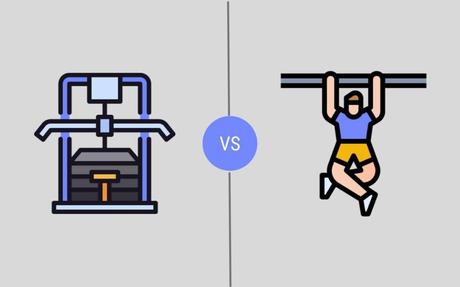When it comes to building a strong upper body, the pull-up and lat pulldown both kick butt. But which is better? Read on as we delve into the timeless deathmatch, err, debate.

Training the back is a cornerstone of an awesome upper body workout routine.
Having a strong and muscular back does more than just fill out a t-shirt: it has practical effects from improving athletic performance, stabilizing the arms, and can also improve your other upper body lifts (ahem, bench press).
Among back exercises, there are two types: horizontal pulls and vertical pulls.
The lat pulldown and the pull-up are the two kings of the castle when it comes to vertical pulls.
In this guide, we are going to take a detailed look at these two staples of back training.
We’ll cover the pros and cons of each so that you can make a decision on where to spend more of your focus at the gym.
Let’s jump right in.
Lat pulldowns – The Basics
The lat pulldown exercise can be done in a couple of different ways.
Seated lat press machine pulldowns are the one most of us are familiar with. Park your legs under the roller, insert the peg into your weight plate of choice, assume the grip on the lat pulldown bar, and off we go.
It can also be done using a resistance band at home or a home gym pulley system.
The lat pulldown works a lot of muscles:
- Lats. These are the primary muscles used in this exercise.
- Teres major. This is a small muscle that runs along the shoulder blade and helps power the lat muscles.
- Traps. Both upper and lower traps are recruited in this exercise.
- Rhomboids. Both the minor and major, found in your upper back.
- Biceps brachii. You know what this one is

- Forearm muscles, including the extensor digitorum, abductor pollicis longus, and so on.
- Extensors and tendons in the hand.
The lat pulldown has a lot of flexibility built into the exercise, with different grip and hand placements targeting different muscles (See: 5 Lat Pulldown Grips and the Benefits of Each).
Lat pulldowns – The Pros
The lat pulldown is a gangster when it comes to building muscle and strength in the upper back.
But there are some specific benefits to this exercise that make it a must-have in your upper body workout routine.






Pull-ups are a simple exercise that is often done with terrible mechanics, and this is partly due to the fact that the exercise starts with a high load. It’s hard to focus on technique when you are simply struggling to do a handful of reps.
Lat pulldowns give you a chance to pull the bar down, and really feel the shoulder blade retraction without overcompensating with shrugged shoulders, pulling the head forward, and so on.
Lat Pulldown – The Cons
Less core activation. Because the body is generally pinned under a roller, there is less core activation when doing lat pulldowns. While the lat pulldown is technically a compound exercise, it does isolate the back and shoulders. With pull-ups, there is much more core activation in order to keep the body rigid when pulling the body up and down.
Incorrect range of motion. It’s easy to cheat on this exercise. The big one is when the bar doesn’t go high enough, soliciting that stretch in the shoulder blade and lats. Getting stronger and building more muscle means going through the full range of motion
Pull-ups – The Basics
The pull up is a bodyweight exercise that challenges the upper body. Starting from a head hang, the body is pulled skyward using the musculature in the back, shoulders, and arms.
The muscles used in the pull-up include:
- Lats. Otherwise known as the latissimus dorsi
- Biceps brachii. Sun’s out, gun’s out!
- Traps. Both the upper and lower trapezoid muscles.
- Deltoid. Not to confused with altoids.
- Erector Spinae. Excellent for lower back stability and strength.
- Rectus abdominis. Core work!

Pull-ups – The Pros







Pull-Ups – The Cons
Now that we’ve sung the praises of the almighty pull-up, let’s promptly throw a wet towel on its efficacy!
Even intermediate lifters will struggle to complete more than 1-3 reps.
Pull-ups are a shake made with two scoops of humility if I’ve ever seen one.
There are plenty of well-conditioned athletes in the gym who struggle to do more than 4-5 proper reps.
Which can make it difficult to hit the hypertrophy sweet spot of 8-12 reps on a consistent basis (without using the pull-up machine or bands).
The temptation of cheating on the short range of motion.
The pull-up is a breeding ground of incomplete range of motion. I’ve done it, you’ve done it: sacrificed the bottom 1/3 of the movement to get a sneaky few more reps in.
Most often, it’s at the beginning of the pull, when people should be in a dead hang.
Pull-uppers will often cheat the bottom end of the movement in order to skip having to overcome gravity and accelerate out of a dead hang.
(That said, this temptation is just as real on the lat pulldown machine. Sometimes you just need to eat that humble pie and reduce the weight so you can hit full range of motion.)
Lat Pulldowns vs Pull-Ups: What’s Best for you?
Lat pulldowns are great for…
- Activating the lats before a big back workout
- Beginners who want to progress to pull-ups
- Mastering the basics of back pull exercises
- Want more control when training the lats
- As a “finisher” exercise to train safely to failure
Pull-ups are best for…
- Athletes who want better power transfer through the body
- Recruiting more core and bicep muscle fiber
- Developing forearm and grip strength
- Working out at home with minimal equipment
- Burning more calories in less time
Lat Pulldowns vs Pull-Ups: FAQs
Should you do lat pulldowns and pull-ups on the same day?
Yes! There are several instances where you should definitely do both exercises on the same day.
Lat pulldowns are an excellent way to activate the lats without going to failure or overloading the nervous system.
Experienced lifters can and should use lat pulldowns as a way to prime the lats and forearms so that they don’t hit the pull-up bar with cold, sleepy muscles.
Lat pulldowns are also a great burner exercise to do at the end of a workout when you want to “rep-out” and train to failure.
Are assisted pull-ups better than lat pulldowns?
The assisted pull-up is a hybrid between lat pulldowns and pull-ups.
You get the best of both worlds, essentially, copying the motor patterns of the pull-up with the weight-assist of a lat pulldown exercise.
For less-trained individuals (people who can do less than 10 pull-ups consecutively), assisted pull-ups are better for lat activation than pulldowns or even pull-ups3.
The Bottom Line
There are a lot of reasons to love both of these exercises, and let’s be honest for a second here…
This might be a “vs” battle, but it’s not an either/or.
They both have a place in every seasoned lifter’s workout routine.
But if you are pressed for time, and only one of the two will suffice, here’s a recap:
- Pull-ups are best for additional core work, forearm activation, and power transfer between the upper and lower body.
- Lat pulldowns are awesome for people easing into lifting weights, want to hit higher rep ranges, and want to really zero in on the lats.
Whichever you choose, may the back strength and muscle be with you!
More Guides Like This
5 Lat Pulldown Grips (Pros and Cons of Each). Conquer the lat pull-down and target the right muscles with this guide to the best grips on the pulldown bar.
6 Lat Pulldown Alternatives for a Strong and Muscular Back. The lat pulldown is a cornerstone of most back-building programs. Here are the best lat pulldown alternatives to help you conquer your workout goals.
